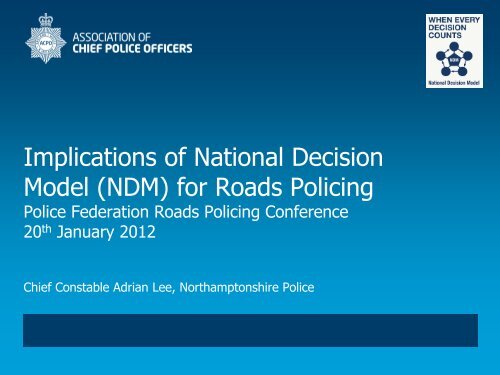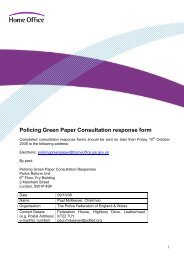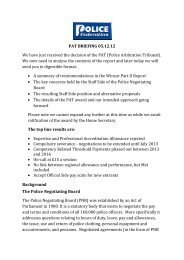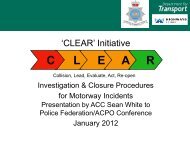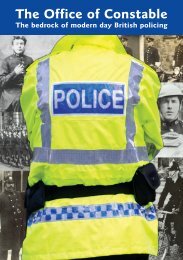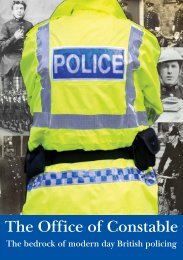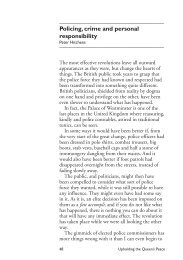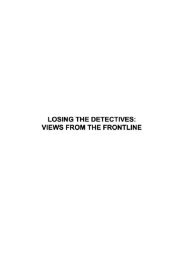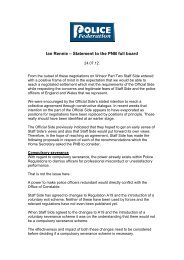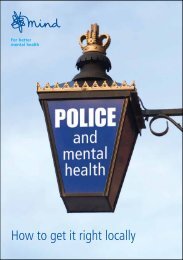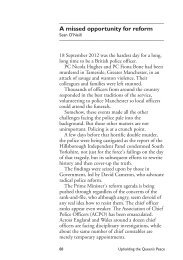Implications of National Decision Model (NDM ... - Police Federation
Implications of National Decision Model (NDM ... - Police Federation
Implications of National Decision Model (NDM ... - Police Federation
You also want an ePaper? Increase the reach of your titles
YUMPU automatically turns print PDFs into web optimized ePapers that Google loves.
<strong>Implications</strong> <strong>of</strong> <strong>National</strong> <strong>Decision</strong><br />
<strong>Model</strong> (<strong>NDM</strong>) for Roads Policing<br />
<strong>Police</strong> <strong>Federation</strong> Roads Policing Conference<br />
20 th January 2012<br />
Chief Constable Adrian Lee, Northamptonshire <strong>Police</strong>
<strong>Police</strong> “Failings” and blame culture<br />
2
Inadequate<br />
Narrative<br />
The cycle: blame &<br />
aversion<br />
Risk emerges<br />
over time<br />
Risk perception emerges –<br />
not always backed up by<br />
facts<br />
Specific incident<br />
Misperceptions are<br />
communicated<br />
Incomplete public debate:<br />
“Something must be done!”<br />
Amplified by<br />
media<br />
Unreasonable expectations<br />
about what can be<br />
achieved<br />
Response (rules,<br />
policies,<br />
guidelines)<br />
Pressure on <strong>Police</strong><br />
Service as the default<br />
risk manager<br />
Some problems<br />
persist<br />
Some harms<br />
prevented<br />
Some unintended<br />
side effects<br />
More calls for action<br />
Diminished personal<br />
responsibility<br />
Frustration with<br />
loss <strong>of</strong> discretion
Risk Aversion and Bureaucracy<br />
<strong>Police</strong> <strong>of</strong>ficers and police staff will have to use<br />
greater pr<strong>of</strong>essional judgment, take greater<br />
risks in their decision making and to use their<br />
discretion in order to achieve the highest levels <strong>of</strong><br />
trust and confidence in policing. In doing so they<br />
will need to know that they have the support <strong>of</strong><br />
their force and that there are clear and<br />
consistent standards against which their<br />
behaviour will be judged.<br />
Sir Ronnie Flanagan, Review <strong>of</strong> Policing – Final Report.<br />
(Feb 2008, paragraph 5.18)
Creating Pr<strong>of</strong>essional Space<br />
“Reasonable Criticism”<br />
Lessons<br />
Learnt<br />
Mission<br />
Law<br />
Values<br />
Knowledge<br />
Narrative<br />
Authorised Pr<strong>of</strong>essional Practice<br />
“Unreasonable Criticism”
Work so far…<br />
June 2007 - Present day<br />
1. Risk Doctrine & Principles<br />
2. Refine our Statement <strong>of</strong> Values<br />
3. <strong>National</strong> <strong>Decision</strong> <strong>Model</strong><br />
4. Develop Training<br />
5. Selection, Recruitment and Advancement<br />
6. Communicate to Staff and Public<br />
7. Audit<br />
6
Risk Principles<br />
1. Willingness to make decisions in conditions <strong>of</strong> uncertainty<br />
is a core requirement <strong>of</strong> the <strong>Police</strong> Service.<br />
2. Maintaining or achieving safety is the primary<br />
consideration in decision making.<br />
3. Risk taking involves judgement and balance.<br />
4. Harm can never be totally prevented. Judge by the<br />
quality <strong>of</strong> the decision making, not by the<br />
outcome.<br />
7
Risk Principles<br />
5. When reviewing decisions, the many factors beyond<br />
an individual 's control should be taken into account.<br />
6. <strong>Decision</strong>s should be consistent with those <strong>of</strong><br />
similar rank, specialism and experience in the<br />
same circumstances.<br />
7. Whether to document a decision is a risk<br />
decision itself. The extent <strong>of</strong> that record<br />
should be based on the likelihood <strong>of</strong> harm<br />
occurring and its seriousness.<br />
8
Risk Principles<br />
8. Reducing risk aversion: a culture that learns<br />
from successes as well as failures.<br />
9. Good risk taking depends upon quality<br />
information.<br />
10.<strong>Decision</strong>s consistent with these principles<br />
should be encouraged and supported.<br />
9
Statement <strong>of</strong> Mission and values<br />
“The mission <strong>of</strong> the police is to make<br />
communities safer by upholding the law<br />
fairly and firmly; preventing crime and<br />
antisocial behaviour; keeping the peace;<br />
protecting and reassuring communities;<br />
investigating crime and bringing<br />
<strong>of</strong>fenders to justice…
Statement <strong>of</strong> Mission and Values<br />
…We will use discretion, pr<strong>of</strong>essional<br />
judgement and common sense to<br />
guide us and will be accountable for<br />
our decisions and actions. We will<br />
respond to well-founded criticism with<br />
a willingness to learn and change”
Mission and Values<br />
Throughout the situation, you should ask<br />
yourself:<br />
● Is what I’m considering consistent with the<br />
Statement <strong>of</strong> Mission and Values?<br />
● What would the <strong>Police</strong> Service expect <strong>of</strong><br />
me in this situation?<br />
● What would any victim(s), the affected<br />
community and the wider public expect <strong>of</strong><br />
me?<br />
12
Multiple <strong>Model</strong>s<br />
Developing the <strong>NDM</strong><br />
SCAN<br />
ANALYSE<br />
RESPOND<br />
ASSESS<br />
13
NCALT E-Learning<br />
Force Preparedness (Jan 2012)<br />
Red<br />
No SPOC identified. Incomplete<br />
plan for implementation <strong>of</strong><br />
<strong>NDM</strong>. 100% compliance NOT<br />
likely by 31/03/2012.<br />
2<br />
Amber<br />
Green<br />
Plans made for implementation<br />
<strong>of</strong> <strong>NDM</strong>. Some concerns about<br />
understanding. 100%<br />
compliance not likely or<br />
achievable Clear plan by and 31/03/2012. buy in for<br />
implementation <strong>of</strong> <strong>NDM</strong>. 100%<br />
compliance expected by<br />
31/03/2012.<br />
19<br />
24<br />
15
Selection, Recruitment & Advancement<br />
Leadership<br />
<strong>Decision</strong><br />
Making<br />
Working with<br />
Others<br />
Pr<strong>of</strong>essionalism<br />
Public<br />
Service<br />
Executive<br />
Strategic<br />
Vision<br />
Leadership<br />
Managing<br />
Performance<br />
<strong>Decision</strong><br />
Making<br />
Working with Others<br />
Pr<strong>of</strong>essionalism<br />
Public<br />
Service<br />
Senior<br />
Manager<br />
Strategic<br />
Vision<br />
Leadership<br />
Managing<br />
Performance<br />
<strong>Decision</strong><br />
Making<br />
Working with Others<br />
Pr<strong>of</strong>essionalism<br />
Public<br />
Service<br />
Middle<br />
Manager<br />
Flexibility<br />
Leadership<br />
Managing<br />
Performance<br />
<strong>Decision</strong><br />
Making<br />
Working with Others<br />
Pr<strong>of</strong>essionalism<br />
Public<br />
Service<br />
Supervisor Flexibility Leadership<br />
<strong>Decision</strong><br />
Making<br />
Teamwork Respect Pr<strong>of</strong>essionalism<br />
Public<br />
Service<br />
Practitioner<br />
Flexibility<br />
Managing<br />
Tasks<br />
<strong>Decision</strong><br />
Making<br />
Teamwork Respect Pr<strong>of</strong>essionalism<br />
Public<br />
Service<br />
<strong>Police</strong> Pr<strong>of</strong>essional Framework replaces Integrated Competency Framework<br />
16
Communication<br />
• <strong>Police</strong> <strong>Federation</strong>, Superintendents’ Association<br />
and CPOSA working with Ethics and Risk Portfolios.<br />
• Firearms and Conflict Management re CMM.<br />
• ACPO Portfolios<br />
• Practitioners<br />
• Pr<strong>of</strong>essional Policing Skills<br />
• Ministers<br />
• Bureaucracy Taskforce<br />
• Media events: Training Journalists!<br />
17
Audit: IPCC<br />
•As an organisation we have been asking ourselves whether<br />
we contribute to risk averse policing, and how we can<br />
challenge misconceptions about our approach to<br />
investigation...<br />
•…police operational decisions involve taking risks and<br />
in assessing decision-making we will focus on whether the<br />
decision was reasonable and proportionate in all the<br />
circumstance as they existed at the time…<br />
•…we recognise that police operational decisions <strong>of</strong>ten need<br />
to take into account competing objectives, timescales<br />
and limited resources.<br />
Deborah Glass, IPCC Deputy Chair, June 2011<br />
18
IPCC: Negative example<br />
• Mr D in custody the previous day for domestic<br />
abuse released without a proper risk assessment<br />
• Four previous cases <strong>of</strong> harassment against the<br />
victim<br />
• Day after release, he abducted and stabbed the<br />
victim<br />
• IPCC Comment: each incident dealt with in relative<br />
isolation, failed to carry out proper risk assessments<br />
and failed to complete the required paperwork,<br />
failed to recognise the nature <strong>of</strong> the incident<br />
19
IPCC: Positive example<br />
• <strong>Police</strong> had attended home to arrest Mr P<br />
• Mr P barricaded himself inside with two children<br />
• Officers with Tasers enter, but a firearm<br />
discharged by Mr P<br />
• After a 16-hour period <strong>of</strong> no contact armed<br />
<strong>of</strong>ficers enter<br />
• Mr P was found dead<br />
• IPCC comment: Difficult decisions had to be<br />
made with the aim <strong>of</strong> trying to protect the public,<br />
<strong>of</strong>ficers, Mr P’s children and Mr P himself<br />
20
Merseyside Example<br />
Safety guidelines 'stopped police from<br />
saving drunk man killed on motorway‘<br />
[Name] had been drinking when he was seen by a passing police patrol<br />
stumbling down an unlit motorway embankment in the early hours <strong>of</strong> the<br />
morning.<br />
But the <strong>of</strong>ficers did not stop to pick up the 26-year-old because they did<br />
not have the right training or equipment.<br />
Daily Mail 2007<br />
21
Wiltshire Case
Practical Application<br />
23
Benefits for Officers<br />
• Simple tool for <strong>of</strong>ficers and staff<br />
• Builds trust and confidence from communities<br />
• Reduces bureaucracy<br />
• Increases discretion and pr<strong>of</strong>essional judgement<br />
• Accountable decision making<br />
• Replaces multiple decision models<br />
• Builds on familiarity with CMM<br />
• Moves Clockwise!<br />
24
Discretion and Pr<strong>of</strong>essional Judgement<br />
• Speed Cameras<br />
• Technology removed discretion<br />
• Loss <strong>of</strong> police legitimacy<br />
• Use <strong>of</strong> Discretion and Pr<strong>of</strong>essional Judgement<br />
• <strong>Police</strong>Witness<br />
• Proportionality<br />
• We cannot delegate our discretion<br />
25
Next Steps…<br />
• Blue Light Agencies:<br />
o Fire/ Ambulance/ Coastguard<br />
• Other Partners:<br />
o VOSA/ Highways Agency/ CPS/ IPCC<br />
• “Skills For Justice”<br />
26
Any Questions?<br />
27


